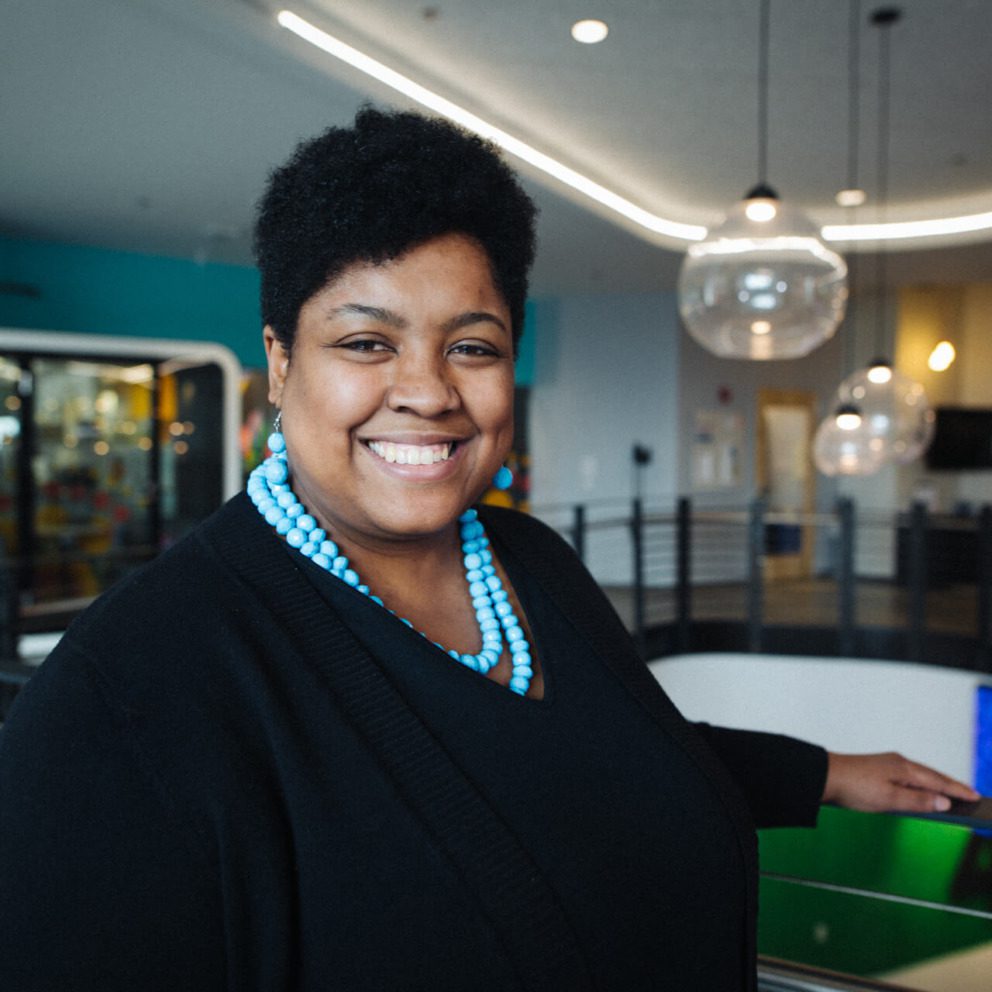Empowering
Parents
The Navigate STL Schools dashboard and programs are helping parents make informed decisions for their children's education.
Anna-Stacia Allen knows what it’s like to be in an ill-fitting school situation. Growing up in Toledo, Ohio, the Navigate STL Schools Executive Director was labeled a problem by her teachers when she was in the second grade because of behavioral issues brought on by extreme boredom. Fortunately, her parents knew to look beneath the surface and refused to accept her teachers’ assessment, digging deeper to find the root cause of why she was having so many issues.
“I was extremely bored, acting out because I was finishing all of my work early,” Allen says. “When they told my parents I had behavioral issues, they said, ‘That can’t be true. She must be bored.’ They had me tested for gifted and talented, and afterward my parents realized that what was happening in the classroom wasn’t fulfilling me. The problem was, my school wasn’t equipped to deal with special kids. Instead of putting me in a different grade or class or giving me higher level work, they just shipped me off once a week to a program. Once I got to college, I had resources to help, but what about the resources to prepare us to get there?”
Thinking back to her own experiences, Allen can’t help but empathize with parents and guardians as they struggle to decide where to send their children to school. It’s a stressful decision, one in which the stakes seem extremely high, but it’s also one that she feels people often go about the wrong way because they are not asking the right questions – and even if they were asking the right ones, there is little information out there to help them make that choice.
Allen is hoping to fill that void with Navigate STL Schools. Founded in 2014 as an ad-hoc collective of parents, then formally launched at the beginning of 2019 as a nonprofit, the organization exists as a resource for parents in the city of St. Louis as they make decisions about their children’s education. Not content with the incomplete picture that school rankings or reputations alone provide, the team at Navigate STL Schools aims to guide parents by tailoring their decision-making to each individual family’s needs.
“You have all of these options in the city of St. Louis,” Allen says. “There are over 150 schools in the city limits that you can send your kids to. This is really about helping parents to figure out which one is going to be the best fitting school for their child. Just because a school has the ‘best’ education doesn’t say anything about what it is like for your particular kid. We are giving data that goes beyond the opinions that are out there.”
As Allen and her colleagues see it, the idea of what makes a good school is not objectively defined, but rather considers each family’s unique situation and priorities. For some, the focus may be purely academic; for others, social values or emotional wellness may be at the top of the list. By collecting data on such factors, sharing them on their website and providing one-on-one counseling services, Navigate STL Schools empowers parents – whether transplants looking to gain information about their new hometown or longtime residents overwhelmed with the decision-making process – to tailor their school choice to their child’s needs and define for themselves what makes a quality education.
“I believe the most important factor for us was finding the right school for our middle child,” says Patrina Letcher, a new-to-St. Louis parent who has found help in selecting the right school for her son through Navigate STL Schools. “He is a special needs child, and it was our goal to find the right resources for him, to find the right programs for him, that would enable him with the self-independence skills he would need as an adult as he grows as well as his education.”
Dasha Kennedy, a financial coach and blogger known as The Broke Black Girl, echoes Letcher’s sentiment. As a parent within the St. Louis city limits, she sees Navigate STL Schools as a way to gain some sort of control over a process that can sometimes feel like it takes on a life of its own.
“I’m just looking at this intermediary, and it makes such a huge difference to have something like this that you can really get involved,” Kennedy says. “For me, it puts the parents in the driver’s seat, so although Navigate STL Schools is assisting us in a very large way, it still puts us in the driver’s seat in advocating for our child. This is something I know I definitely could benefit from, and I’m even thinking of my friends who have children in school and how they made the decision that they made. Was it just a school that was local? Was it a recommendation? How deeply do we think about where we are sending our children?”
Allen is emphatic that Navigate STL Schools is about providing information to parents and guardians regardless of race, economic status or academic ability, and works under the belief that every family has the right to resources so that they can advocate on behalf of their child. Since the group’s start, when a circle of parents banded together and created an online school search resource, the organization has bolstered its website and data collection abilities and launched several programs that help parents with things such as determining what their priorities are in a school, gathering information to make an informed decision and arranging visits with specific schools.
Through its online platform Allen and her team hope to demystify the nebulous notion of a “good” school through actual data points on every public, charter and private school within the St. Louis city limits (and eventually beyond). They’ve gathered data through the Missouri Department of Elementary and Secondary Education, the U.S. Department of Education’s Office of Civil Rights and self-reporting from individual schools. Parents or other caregivers interested in researching schools can go onto the organization’s website and perform a search that will pull up a list of all schools, or specific ones based on search terms, and give a basic overview of factors like student learning or safety and climate. They help parents visualize the data with icons that show how schools compare on a city or state average to others in the city. Clicking on an individual school from that list leads to even more information, including the school’s diversity picture, mission statement, cost and education focus, allowing caregivers to get a holistic picture of what a school is all about.
“People ask what makes a good school,” Allen says. “It’s not my job to determine what a good or bad school is. My job is to help people discover what they value and what a good education means to them. You don’t need me to come in and tell you that this is a top-ten school in St. Louis; you need to know what is a good fit for your student. We’re not a school choice organization – that’s not my business. We’re here to tell you that there are options out there and help you find out what you value.”
While they did a soft launch of the website in April, Allen and her team are moving full steam ahead with Navigate STL Schools this fall. Though their plans have had to morph due to COVID-19 precautions – in-person group events and school tours have had to be put on hold as they work out how to do so safely – they are confident that their efforts are resulting in a resource that will increase educational outcomes for students. They also see it as a community-building tool for the city of St. Louis, through allowing people to understand that there are excellent educational opportunities for their children within the city limits, which, Allen admits, bucks the perception of the St. Louis Public Schools system. Their hope is that the dashboard can open parents’ eyes to a world of opportunity right outside their front doors. All they have to do is be willing to see it.
“It’s powerful if you think of how education can transform,” Allen says. “I saw something about how there aren’t going to be any more snow days because schools have figured out how to offer education online. It was a funny thought, but it makes you think of what other conventions exist because of how we are traditionally educated and were created for a world that doesn’t exist anymore. It’s time to look at how we educate students and see how that works for families regardless of things like a parent’s educational level or type of employment. Just because a program is great for your family doesn’t mean it will be for another. Every building has something to offer your kids.”
Join the Story
Check out the latest information on navigatestlschools.org.








